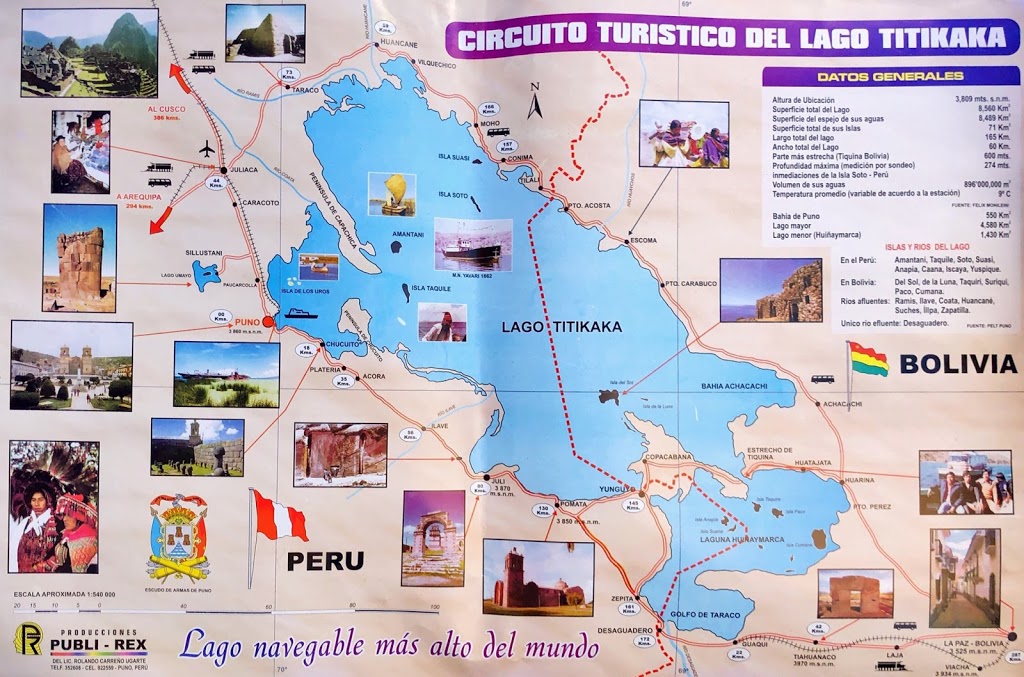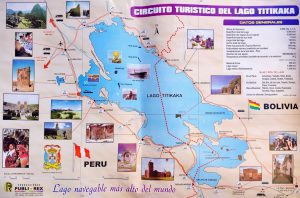Lake Titicaca (‘grey Puma’) is the highest navigable lake in the world at 3800m. It’s a vast body of water stretching for 165km and a total area of 8555km2. The lake is bordered by both Peru and Bolivia.
At its deepest point, the lake is 285m deep. In the 70s, Jacques Cousteau unsuccessfully attempted to reach the bottom and found some of the largest frogs on the planet – 50cm! These had adapted to stay underwater for extended periods. There is nothing dangerous in the lake.
The lake was formed with the shifting of tectonic plates 300 million years ago. Today, it still has some salt in it so is not good for irrigation. Farmers still find evidence of its origins in the mountains with seas shells and sea horses. Water now enters the lake from the Royal Mountain, and exits via a river to Bolivia.
The Aymara warriors have inhabited the areas area around the lake for hundreds of years and regard themselves as some of the oldest peoples in the world. They speak their own language, similar to Quechua the Inca language.
Our trip to Lake Titicaca includes a couple of days of
We stopped for lunch at Taquile island, an island of about 2000 people, recognised for their famous textiles. Here, single men and boys knit every day, originally using cactus needles to make fine hats and belts, learning from about age 6. They were recognised by UNESCO in 2004 as the best knitters in the world.
The knitting is woven into their social structure. Men are not considered worthy of marriage until they are able to knit a hat so fine that no sunlight can get through, and it’s waterproof.
Until they are married, men are not allowed to drink or contribute at community meetings. I’m starting to see merit in this system… however apparently it means men get good at knitting and marry young!
The clothing is heavily influenced by the Spanish, with a bull fighting style. The colours and way that the hats and belts are worn provide guidance about whether men are married, single, ‘engaged’, or looking for a girl.UIKeyInputDownArrow
Since the 1990s, tourism has helped the island develop. They now have a school and hospital, and each family has the opportunity to make money via the restaurant or the craft market (not both).
We headed over to Amantani island, about 6km away. This has about 4000 residents and is our homestay for tonight.
The houses are simple mud brick structures, all with fabulous views over the lake. Many of the families are ‘empty nesters’ with children heading off to Lima for university or Puno for work.
Here, the ladies knit and the men spin – such a contrast for two islands so close.
We met our family – Eugenia, Wilma, and their 3rd child, 12 year old Josaline. Josaline was doing homework at the kitchen table in between helping Mum with dinner… iPad? This house only has about 6 electric lights! Josaline is also learning to knit the hats and crafts that are widely available on the island, and loaned to tourists. Her hand knitted llamas will be the Xmas decorations for 2018!
From the top of the island there are amazing views across the Lake to other islands, and to the Bolivian mountain peaks in the distance. We hiked up there to watch the sunset… 2 km of steep slope to reach 4111m. The Milky Way appeared as we headed back down… with the Southern Cross as the centrepiece.
After dinner we were dressed in traditional clothing and taken to the community hall for a fiesta of music and dancing. I don’t know if it was our light hair and pale skin, or the hiking pants and trail shoes… regardless we looked like the most unlikely Peruvians!
There’s no heating, so we’re huddled under layers of woollen blankets. It works! Back in the kayaks tomorrow for the return trip to Puno.
Love M & the Bunch x


Comments are closed